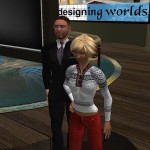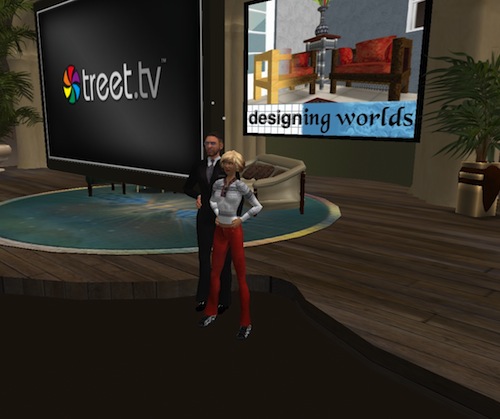 Treet TV are ground-breakers and Australia-based ones at that. I’ve been following them since mid-2007 (original profile here) when they were the Second Life Cable Network (SLCN), and they’ve been plugging away ever since, growing to arguably the world’s most credible and prolific virtual world TV production outfit. I say plugging away because even though they have a pretty solid track record now as innovators and quality content producers, establishing a wider profile within the Australian business sector has been a challenge.
Treet TV are ground-breakers and Australia-based ones at that. I’ve been following them since mid-2007 (original profile here) when they were the Second Life Cable Network (SLCN), and they’ve been plugging away ever since, growing to arguably the world’s most credible and prolific virtual world TV production outfit. I say plugging away because even though they have a pretty solid track record now as innovators and quality content producers, establishing a wider profile within the Australian business sector has been a challenge.
Treet’s Mt Eliza-based founders, Gary Wisniewski (SL: Wiz Nordberg) and Grace Roberts (SL: Texas Timtam), caught up with me for a chat last weekend on everything Treet plus some broader themes. If you’ve thought about getting a team together to make your own show, read on as Treet are interested in new pitches.
Lowell: We last caught up in June 2007 when you were still SLCN TV – what are your strongest memories of those early times for you?
Wiz: Strongest memories? Â Confusion. 🙂 No, really, I suppose the strongest memory is how “new” the idea was, of using a virtual worlds platform to create true television-like content, and the reaction of people to what we were doing. It was very fresh and very new and it seemed like there were limitless possibilities.
Texas: It was very exciting then. We were learning new things everyday and it was still in the glory days of Second Life hype so everyone around us was filled with optimisim about the opportunities.
Lowell: So has that confusion abated or just changed in dynamic?
Wiz: Well the dynamic has changed a lot. It is no longer new, and a lot has been learned – I was only joking when I said confusion actually.
Lowell: On learning: if you had to list a few key learnings over the past three years, what would they be?
Wiz: It seemed obvious to us that doing virtual worlds television was the right thing to try. Â I have to say it was almost the opposite of confusion, but total confidence back then. Well, one thing we learned is that people in Second Life have almost boundless energy to create, and to us it is the reason to remain committed to Second Life despite many people’s negative feelings about it right now. We also learned to divide machinima into two broad categories: documentary and story telling. Documentary is easy. Storytelling is hard. I suppose the list could go on for pages. Â After three years, you learn a lot of things!
Lowell: So for those who don’t know Treet TV, can you give an executive summary of what it offers today?
Wiz: Treet TV offers the largest collection of live television broadcasts and archives made almost exclusively in Second Life, documenting the activities, sports, lives, and stories of Second Life residents and creators.
Lowell: Your work is most recognised in Second Life but do you use other platforms / grids?
Wiz: We are starting to use OpenSim and you will see a lot more OpenSim based shows in the coming year. But almost everything is still done in Second Life.
Lowell: What are the limitations of OpenSim so far when compared to what you do in Second Life?
Wiz: The limitations don’t apply to us at Treet so much as they apply to those creating and participating in the shows. Â Filming in OpenSim can be done as perfectly as we do it in Second Life. The main limitations show producers face are – there are fewer people and thus less diversity to pool upon for guests, interviews, lifestyle and sports content; there are fewer vendors of products, thus less available if you want to devise your own original show content; and stability is, incredible to say, not as good as Second Life, so the production reliability is lessened. But those things are changing fast, I should add.
Texas: OpenSim-based grids are just now gaining enough momentum to have enough users that will make for interesting viewing and stories to tell.
Lowell: Second Life has copped a lot of negative press: what do you see as its strong points and do you remain confident in its longer-term viability?
Wiz: The strong point of Second Life is that it is a new kind of virtual world, based upon an empty slate, where people can do and create what they wish without any limit to their imagination. Â Arguably Linden Lab invented this type of world. Â I am not sure they will end up playing a major role over time, but I am certain that this kind of world will survive, grow, and probably displace many many other types of virtual spaces. I am confident in the long term viability of such worlds. Not so much of Second Life itself. But today, Second Life is the best.
Lowell: Without going too negative ourselves, what is it about Linden Lab and Second Life that makes it likely to be overtaken?
Wiz: The need for Linden Lab’s product has grown beyond their ability to service it and respond to the market. This has to do with very early decisions they made before they realised what they really had. Some of those decisions will be hard to recover from, and I’m not sure they can.
Lowell: What in your opinion were those key decisions – architecture related, community related or others?
Wiz: Most are architecture related. Essentially, they locked themselves into an architecture where it takes approximately 25% of the resources of a fairly high-end server to support a gathering place with 100 people. Imagine for example, that you required  a full Xeon server to accommodate a website which would accommodate 400 people.  You would have a huge liability. This is the reason for most of their problems, including the inability to scale, and inability to create cheap land available to more people who perceive it as having much better ROI. I am not sure any amount of “thinking outside the box” in terms of their customer service and company structure can make up for that problem.
Lowell: The thing is, as OpenSIm evolves they may avoid some of those issues but not all – are the architecture issues really that solvable in the short-term?
Wiz: OpenSim has the same liability in terms of architecture, but it has the advantage of greater ROI with reduced cost. This will cause more people to engage with it, and more people can be involved in trying to rejig the architecture to solve some of these major problems. Open source groups have proven time and time again that “if there is a will, there is a way”, and I have a lot of hope for OpenSim because I think it will soon reach a tipping point where the necessary technology people will be able to truly hunker down and start making dramatic steps forward. In the short term? Â No. 🙂 That means that those of us who are already at the limits of our patience need to be more patient still!!
Lowell: Let’s talk business for a while – I can imagine you still struggle with the credibility issue i.e. that a lot of the business / funding sector see virtual worlds work as R&D rather than ROI. Are you seeing that shift at all?
Wiz: Well, we don’t struggle with it so much at Treet. We are very committed to having a broad range of content creators producing shows. While there are surely revenue issues we now struggle with because corporate money is not flowing like it once did, this is a shared problem we all deal with. I also believe virtual worlds have been R&D all along. I think that any assumption that there was ROI was predicated by assuming a great deal of PR leverage for having “engaged in something new”. Once you remove the PR leverage, much of the ROI for many corporations didn’t hold up under scrutiny.
Lowell: So obviously without expecting explicit detail, what is Treet’s business model and strategy?
Wiz: Treet is like any other start-up gambling on the increasing trend to do something online which has never been done before. So, our business model evolves and changes over time and mostly is a model of “sustainability” at this point, mainly because there is so much R&D going on in the area we’ve chosen. I think the biggest limitation of any business model for a virtual worlds content company is the small size of the market.
Lowell: Which is a good lead-in to your shows – how many shows do you now produce?
Wiz: 12 shows are currently in production, 10 of them with weekly episodes that are aired live every Sunday and Monday. We have over 3000 archived episodes, not only of those shows, but of many shows no longer in production, or special events and features.
Lowell: What are your most successful shows, both as far as view statistics but also in regard to audience feedback?
Wiz: The three most successful shows in terms of feedback and numbers are Metanomics, Tonight Live with Paisley Beebe, and Designing Worlds….not necessarily in that order. Some shows actually have much greater consistency than those, with very loyal audiences, but haven’t achieved the high points those have. Two notables are the Best Practices in Education Series and the ISTE Eduverse series, both of which are short term productions and both achieved signifcant viewership and web buzz.
Lowell: Over your time producing such a large amount of content – have you discovered any unique trends on what works in SL as compered to more mainstream TV production? That is, have any of the shows worked really well when you thought they wouldn’t or vice versa?
Wiz: Comparing SL to mainstream TV is an interesting “apples and oranges” exercise. Â The viewership of each is fueled by very different things. The “unique trend” is that Internet based TV is more dependent upon having an active community surrounding the content. Mainstream TV is more dependent upon a streamlined and efficient delivery channel. The former requires more social capital. Â The latter requires more financial capital.
Lowell: On community: does Treet do active engagement there or is it more up to each show’s team to drive that?
Wiz: It is a combination. Â Each of our shows is a partnership. Â Treet works actively to build a community of those interested in “virtual television” and many people’s shows are discovered because there is crossover from the Treet community. Â On the other hand, each show brings new communities to Treet, and this is probably one of the main ways Treet’s viewership grows, by having each producer’s community join in a larger community which has greater momentum. Three years ago it was the reverse. Â Treet had no community and it was show communities which essentially “bootstrapped” Treet into having people who could cross-over into other communities. Â Now, such crossover is the norm.
Lowell: On the partnership, how does that work? Where are the boundaries with creative control etc?
Wiz: We try our best to let our producers do what they want.  That’s the honest truth.  We try to let them envision the show, decide on the format, and drive the creative behind the shows with little or no intervention from us. We try to provide feedback about audience size, live viewership, and if we do exert creative control, it has more to do with the mechanics, such as trying to assure that shows are more “watchable” on the web, that intros are the right length, that advertising is used in ways that are most effective.
Texas: The Treet website offers the ability to include a much larger audience than could be achieved with only the Second Life residents. We can live stream to a much larger number of viewers via the web.
Lowell: So let’s say I have a great show concept and I approach Treet and you like it a lot as well. What happens from there?
Wiz: We are very interested in new pitches at the moment. We have a number of broadcast slots open because of the way we have rearranged our schedule. The main thing people with show ideas need to consider is that it is not about the idea or concept. A good concept does not make a show. A good, dedicated team, and a lot of effort in production make a show. A good concept helps because it makes it easier to attract people to the effort, and of course, once the show is produced, it makes it more appealing. But, building a team, and being realistic about the effort required at production are the most important things for people to consider. Two shows, “The Daily PWN” and “The Grid’s Honest Truth” are complete outside machinima productions which air on Treet. Â Most people think Treet “wants” to produce everything. Â That is not at all true, we are very receptive to people doing complete productions. Â But – our requirements are rather stringent.
To be honest, the realities vary from show to show. For sports shows, there is no script, the main thing is being sure that announcers are ready, and that stats are prepared.  Some shows require a script, and there is a completely different team effort.  Some shows require 1 hour per week of pre-production, some shows require 40.
Texas: We are also keen to include serial stories to Treet. Not necessarily produced by us.
Lowell: Texas you mentioned serials and Wiz you mentioned earlier that story-telling is difficult – is that an area you’d like to do lots more in?
Texas: Yes, very much. Moving from a live broadcast model to post-produced drama / comedy is another exercise in “apples & oranges”. Â :)Â But we are very interested in headed that way.
Wiz: Yes! We would love to have more people who are willing and interested in working with us on fictional series.
Lowell: Who are the core Treet TV team besides yourselves now?
Wiz: There are four of us that make up the core team right now, Wiz, Texas, August Lusch, and Yxes Delacroix. We have many other people assisting as well.
Lowell: Is Treet now a profit-making entity for you all? If so – what is your primary revenue source?
Wiz: No, Treet still runs in the red. It is funded by Texas and I. We do have a 24/7 studio which is unlike any other in the world, capable of doing these kinds of live broadcasts for anybody, so we are always interested in corporate work and other revenue, but ultimately, we are building a brand and an audience with Treet and revenue will require that it grow several times larger. As it is, however, Treet has over 100,000 monthly viewers across all our shows, but doing what we do is expensive, and even that many viewers doesn’t really generate enough revenue to fund this.
Lowell: Crystal-ball time: what are your ambitions for Treet in the coming 12-24 months?
Wiz: Expansion in two areas. First, to involve more and more independent machinima producers in Treet to take advatnage of our distribution and audience, and to add to the diversity of our content. Second, to move more and more into OpenSim specificaly and any other platforms we see that have “creator leverage” in the way Second Life does. We also have a couple interesting things we are doing that we can’t talk about . We also expect to continue to work more with Linden Lab – we have had many good joint promotions with Linden Lab and they have helped us fuel growth in many ways.
=====
A disclosure: I’ve appeared once on Tonight Live with Paisley Beebe and once on The 1st Question with Pooky Amsterdam.




Recent Comments